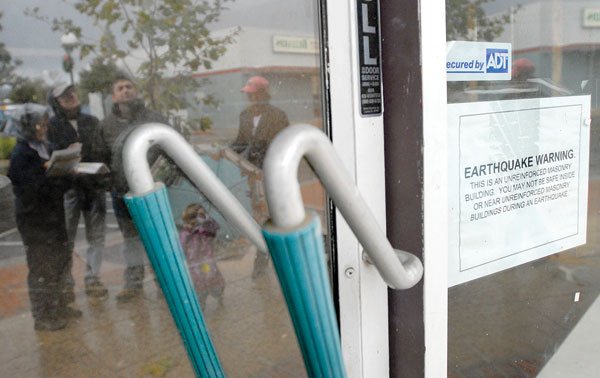
While dealing with downtown Gilroy’s unreinforced masonry buildings has been like “pulling teeth,” the city and individual property owners say they’re making progress in bringing the structures up to the city’s earthquake safety code.
Five properties of the 18 original unreinforced masonry, or URM, buildings are currently under construction and three properties are now in compliance with the city’s ordinance—two through retrofit work and one via demolition.
“I see the URMs as the missing teeth in the smile of downtown,” said Council Member Perry Woodward, who also serves on the city’s URM Task Force, comprised of downtown building owners, Mayor Don Gage and city staff. “To mix metaphors, this process has been like pulling teeth but we’re making progress and I think we’ll get there.”
If work continues at the current pace, Gage and Woodward estimate downtown’s URM buildings could be taken off the city’s to-do list by the end of 2016.
“I think that by the end of 2015, we should have a majority of them complete—which is more progress than we’ve made in 20 years. I think we’re doing well and we’re learning a lot and making changes as a city,” Gage added.
Only one property owner has not come to the table at this point, and the property owner of 7515 Monterey Street has not submitted a formal application to the city to retrofit the building. In August, the city had three nonresponsive owners.
“It’s a lot better than it was,” downtown property owner Gary Walton observed. “When we started (in November 2013), there were 18 people who weren’t talking to the city.”
Both city officials and property owners agree getting everyone at the same table—though the discussions can sometimes get impassioned—has helped spur on progress downtown.
On a recent morning, eight people gathered around a conference room table in the engineering department of City Hall for a meeting of the URM Task Force—including Mayor Don Gage, downtown property owners, city staff and a prospective business owner.
“I don’t want to leave here without a deal,” Walton remarked.
After more than an hour of debate and discussion, both the city and property owner Kirk Tuckness, reached an agreement to check off one more URM property off the list.
Tuckness, who owns 7455 Monterey Street, has an outstanding penalty of $15,000 for not complying with the city’s URM ordinance, and an additional $15,000 in late fees for not paying the original penalty. As long as retrofit work is completed as promised within 60 to 90 days and $15,000 of the $30,000 is paid, the city agreed to remove $15,000 in penalties.
“The bottom line is we want these buildings done,” Gage said. “We want people to understand we’re serious about it and we’ll get rid of the penalties if the business is done on schedule.”
In June 2013, the City Council approved placing liens on the properties of owners who neglected to bring their buildings up to code—a controversial move Gage says drew property owners to the bargaining table in the first place. Under the ordinance, a maximum of $30,000 in fines and penalties can be levied.
That tactic left a bad taste in the mouths of property owners like Steve Ashford, who owns Ashford’s Heirlooms with his wife. If the city removed some of the fines and penalties it levied originally, building owners would have the money to do the retrofit work needed to get their buildings up to code.
“We have gotten a lot done and we’ve seen some major changes made in our building department,” Ashford said, as a result of the task force meetings. “We’re seeing some help. (Community Development Director) Kristi Abrams has done a lot, but the liens aren’t helping at all. If we want to get it fixed, we need to work together… We want to do business in our town but we want to see our neighbors grow as well.”
Ultimately, the end goal is to get the buildings fixed, Walton said.
“What we’re trying to do is get buildings done, so if we’re tripping over the fines and preventing something from getting fixed, we’re working against ourselves,” he added. “What good is it if there are more fines on a building than it’s worth?”
But Gage counters that the fines and liens brought concerned property owners to the table; they realized then the city was taking its URM ordinance seriously, he said. Unless property owners make significant efforts to comply with the ordinance, the chance of the City Council reducing penalties is close to nothing, he added.
Linda Williams, who said she plans on purchasing Tuckness’ building and paying for any necessary retrofits, suggested the city expand on its new tactic and offer to reduce outstanding fines for other building owners if they agree to adhere to a strict construction schedule—like she did.
“You guys use the fines as an effective tool to get people to come to the table and start the work. It seems to me you could use forgiving those fines in the same way,” she said, addressing city officials. “You’d get double bang for your buck. We are where we are and we’ve got empty buildings. Maybe you could use that stick hanging over their head (fines and penalties) in a positive way as an incentive—I can get rid of that fine if I do the work.”
“We’re making a lot of progress,” Gage remarked. “It’s not as fast as I’d like to see, but I think everyone is working together now. Sometimes our meetings get quite active, but we’re going to continue to move until we get them all taken care of.”













